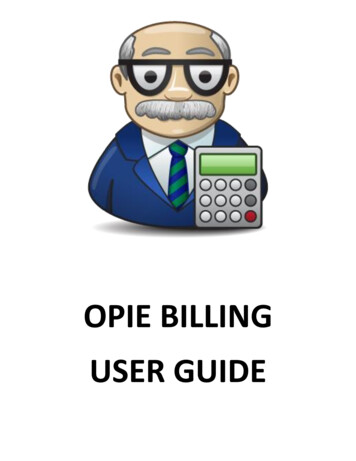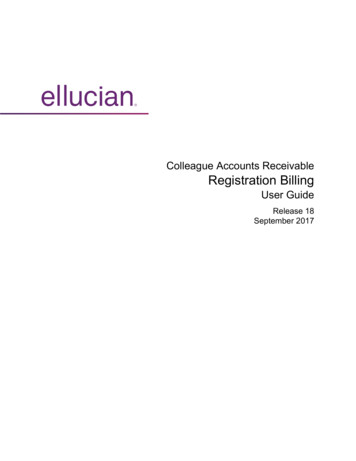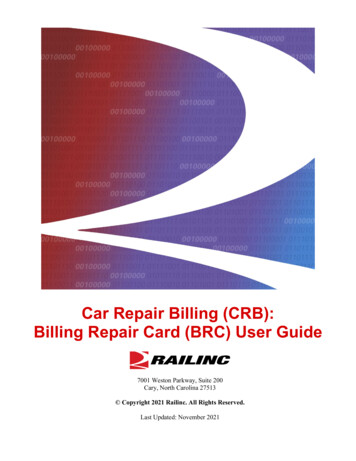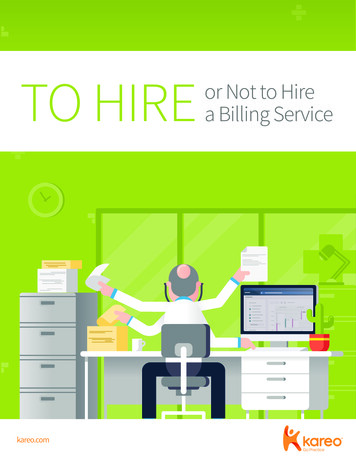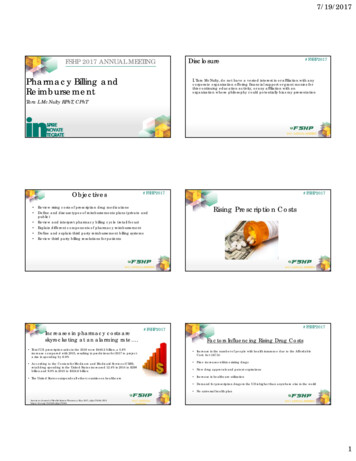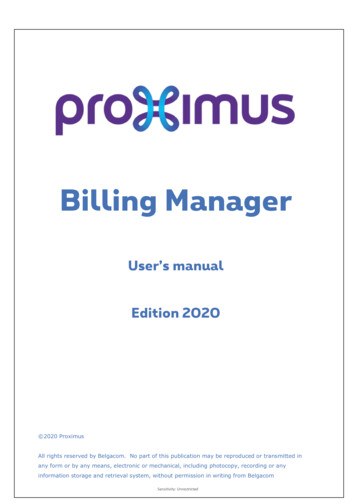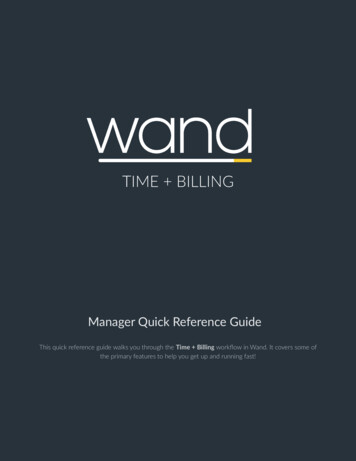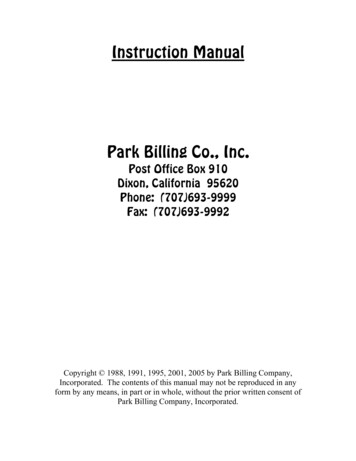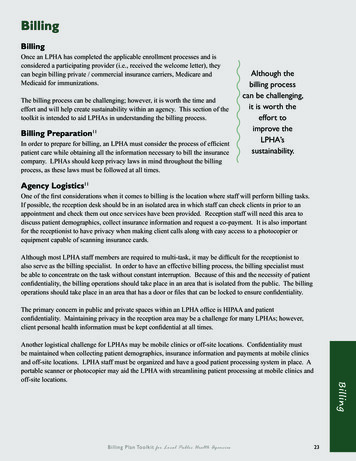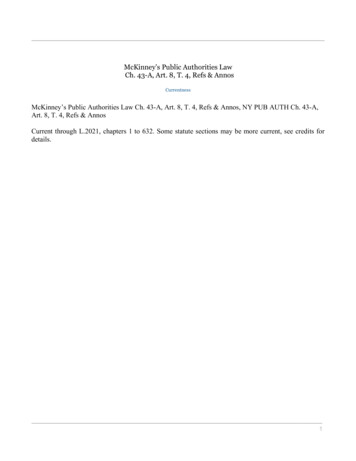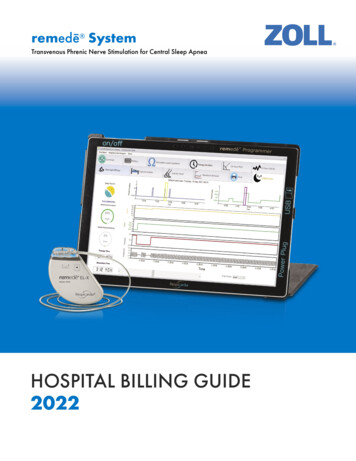
Transcription
remedē SystemTransvenous Phrenic Nerve Stimulation for Central Sleep ApneaHOSPITAL BILLING GUIDE2022
The remedē System Hospital Billing GuideThis guide contains hospital coding and reimbursement information for procedures associated with the placement of the remedēSystem to treat moderate to severe central sleep apnea.Disclaimer: The information provided in this guide is general reimbursement information only; it is not legal advice, nor is it adviceabout how to code, complete or submit any claim for payment, nor is it intended to increase or maximize reimbursement by anythird-party payer. All coding and reimbursement information is subject to change without notice. The content provided by the Centerfor Medicare and Medicaid Services is updated frequently. It is the responsibility of the health services provider to confirm theappropriate coding required by their local Medicare carriers, fiscal intermediaries, and commercial payers.ZOLL provides reimbursement case management and hotline services in order to support patient access to the remedē Systemtherapy. We provide hands-on assistance to physicians and hospitals with prior authorizations and appeals through our remedēPatient Access Program. We also provide reimbursement support of billing, coding, and coverage related activities: Prior authorizations Prior authorization appeals/peer-to-peers Claim appeals Billing/coding/coverage questionsFor questions or case management support, please call the remedē Reimbursement Hotline at1-952-540-4470 or email questions to reimbursement@remede.zoll.com.This guide and all supporting documents are available for download at remede.zoll.com/reimbursement.remedē System Hospital Billing Guide 20222
CONTENTSTRANSVENOUS PHRENIC NERVE STIMULATION FOR CENTRAL SLEEP APNEA.4Therapy Overview. 4Device and Implant Procedure. 4Postoperative Care. 4COVERAGE.5FDA Approval. 5Medicare Coverage. 5Private Payer Coverage. 5Reimbursement Denials. 6CODING.6Diagnosis Codes. 6Hospital Outpatient Codes. 7Hospital Inpatient Codes. 9Ambulatory Surgical Center Codes. 9MEDICARE BILLING AND PAYMENT. 11Billing Considerations.11CMS Transitional Pass-Through Payment (TPT).11Medical Unlikely Edit (MUE) Billing Guidance.11Hospital Outpatient Billing Example . 12Hospital Outpatient CMS-1450 Example. 13APPEALING A DENIED CLAIM OR PRIOR AUTHORIZATION REQUEST. 14FREQUENTLY ASKED QUESTIONS. 15remedē System Hospital Billing Guide 20223
TRANSVENOUS PHRENIC NERVE STIMULATION FORCENTRAL SLEEP APNEATherapy OverviewThe remedē System is an implantable system that safely and effectively treats moderate to severe Central Sleep Apnea (CSA) inadult patients.1 CSA is a serious breathing disorder that disrupts the normal breathing pattern during sleep and has been shown tonegatively impact quality of life and cardiovascular health.2 The remedē System is an implantable system that stimulates a nerve inthe chest (the phrenic nerve) to send signals to the large muscle that controls breathing (the diaphragm).In a clinical study, the remedē System has been shown to significantly improve CSA patient outcomes: 91% of patients had a reduction in the number of sleep apnea events per hour at 12 months3 82% of patients had an improvement in quality of life3 95% of patients would get remedē again3Device and Implant ProcedureThe remedē System is placed during a minimally invasiveprocedure. The system consists of a battery poweredImplantable Pulse Generator (IPG) device placed under theskin in the upper chest area with one or two small thin wires(leads). One lead delivers the therapy to stimulate the phrenicnerve (stimulation lead). For select models, an optional sensinglead may be used for diagnostic purposes to sense breathing(sensing lead).Pericardiophrenic VeinStimulation LeadPostoperative CarePhrenic NervePostoperative care is recommended to optimize therapy withthe remedē System. Regular patient follow-up should bescheduled every 3-6 months to monitor the condition of theIPG battery and to confirm that therapy settings areappropriately programmed.The IPG should be replaced when the IPG battery has beendepleted and either the Elective Replacement Indicator (ERI) orend of life (EOL) indicator is displayed on the remedē Systemprogrammer.DiaphragmThe decision to remove the remedē System is the responsibilityof the physician and patient, and should be determined on acase-by-case basis.remedē System Hospital Billing Guide 20224
COVERAGEFDA ApprovalThe remedē System received Premarket Approval (PMA) from the FDA on October 6, 2017. The FDA-approved indications foruse are as follows:Indications for use: The remedē System is an implantable phrenic nerve stimulator indicated for the treatment of moderate tosevere Central Sleep Apnea (CSA) in adult patients.Contraindications: The remedē System is contraindicated for the following: Patients with an active infection Patients known to require Magnetic Resonance Imaging (MRI)The Instructions for Use document provides further information regarding the procedure, indications for use, contraindications,warnings, precautions, and potential adverse events. The FDA has posted 1) the Summary of Safety and Effectiveness Data(SSED), 2) the FDA Approval Letter, 3) the Implant System Directions for Use (Physician Labeling), and 4) the Patient Guide (PatientLabeling) on its website located proved-devices/remeder-system-p160039Medicare CoverageCurrently, there is no National Coverage Determination (NCD) related to the remedē System. Check with your local MedicareAdministrative Contractor (MAC) regarding any Local Coverage Determinations (LCDs) related to the remedē System. Medicaremay cover the remedē System on a case-by-case basis, with evidence of medical necessity. While traditional Medicare does notrequire or allow prior authorization or prior approval for procedures, Medicare Advantage plans are managed by commercialpayers who may require prior authorization for Medicare Advantage patients. Check with your plan administrator for any priorauthorization requirements.Private Payer CoverageCommercial insurance coverage policies vary and a prior authorization is recommended even if it is not required by the payer.Proceeding without a prior authorization may result in a claim denial and non-payment. We encourage health care professionals(HCPs) to contact payer(s) directly with questions regarding coverage policies or guidelines for the remedē System.ZOLL offers the remedē Patient Access Program which can assist in determining the availability of coverage for your patients andfacilitating prior authorization support services.remedē System Hospital Billing Guide 20225
Reimbursement DenialsThe remedē System is currently classified with CPT Category III codes by the American Medical Association. CPT CategoryIII codes are a set of temporary codes that allow data collection for emerging technologies, services, procedures, and serviceparadigms.4 Many payers initially deny therapies with a CPT III code as investigational or experimental and an appeal may berequired to obtain a successful prior authorization or claim approval for the remedē System. Most commercial health plans havea method by which denials can be appealed through a process documented in the plan Provider Manual. The remedē PatientAccess Program can assist you with this process. Contact the remedē Reimbursement Hotline for additional information andresources to support your patient’s appeal process.CODINGThis coding information is provided for general reimbursement information purposes only. It is not intended to provide adviceabout how to code, complete or submit any claim for payment, nor is it intended to increase or maximize reimbursement by anythird-party payer. It is the responsibility of the health services provider to confirm the appropriate coding required by their localMedicare carriers, fiscal intermediaries, and commercial payers.Diagnosis CodesThe remedē System is used to treat moderate to severe Central Sleep Apnea (CSA) in adult patients. Diagnosis coding forCentral Sleep Apnea may include the following codes:ICD-10-CM Diagnosis CodesICD-10-CM CODE tral Sleep ApneaG47.32Central Sleep Apnea due to high altitude periodic breathingG47.37Central sleep apnea in conditions classified elsewhereProcedure or Device Follow-up CareZ45.42Encounter for adjustment and management of neuropacemaker; brain, peripheral nerve, spinal cordremedē System Hospital Billing Guide 20226
Hospital Outpatient CodesHospitals report outpatient procedures using CPT codes. The remedē System is currently classified as a CPT Category III code,which is indicated by the alphanumeric indicator “T” at the end of each code.For hospital outpatient payments, Medicare assigns each CPT code to a specific Ambulatory Payment Classification (APC). EachAPC has a fixed payment amount which includes the cost of any devices. The Status Indicator (SI) “J1” indicates the primarycode and all other procedures performed are considered adjunctive and included in the single C-APC payment rate. Codes withStatus Indicator “S” means that the code is not subject to a reduction in payment when submitted with another higher-ranked codebut does not receive separate payment when included on a claim with another J1 code. Regardless of whether a code receivesseparate payment, all appropriate HCPCS and CPT codes that correctly describe procedures performed and documented may bebilled.Medicare Payment Status Indicators, Ambulatory Payment Classifications (APC), and national average payments are providedbelow for procedures commonly associated with the remedē System. The Medicare fee schedules listed are a national averageand have not been geographically or wage adjusted.Hospital Outpatient CodesCPT CODE 5DESCRIPTIONOPPS STATUSINDICATOR62022 MEDICARENATIONALAVERAGEPAYMENT65465J1 30,063.48546354635465J1J1J1 11,483.38 11,483.38 30,063.485461J1 3,345.7354615461J1J1 3,345.73 3,345.735465J1 30,063.485461J1 3,345.735461J1 3,345.73OPPS tion or replacement of neurostimulator system for treatment ofcentral sleep apnea; complete system (transvenous placement of rightor left stimulation lead, sensing lead, implantable pulse generator)sensing lead onlystimulation lead onlypulse generator onlyRemoval0428T0429T0430T0431TRemoval of neurostimulator system for treatment of central sleepapnea; pulse generator onlysensing lead onlystimulation lead onlyRemoval and replacement of neurostimulator system for treatment ofcentral sleep apnea, pulse generator onlyRepositioning0432T0433TRepositioning of neurostimulator system for treatment of central sleepapnea; stimulation lead onlysensing lead onlyProgramming0434TInterrogation device evaluation implanted neurostimulator pulsegenerator system for central sleep apnea5742S 102.530435TProgramming device evaluation of implanted neurostimulator pulsegenerator system for central sleep apnea; single session5742S 102.530436Tduring sleep session5724S 939.61remedē System Hospital Billing Guide 20227
Hospitals use HCPCS Level I (eg, CPT ) and HCPCS Level II codes to report hospital outpatient services. CPT codes are assignedfor the implant procedure and HCPCS II codes are assigned to identify the device itself. Level II HCPCS codes are reported byfacilities when they have purchased and supplied the device and are required to be reported to Medicare. The following HCPCSLevel II C-codes may be appropriate for Medicare hospital outpatient reporting. Some non-Medicare payers recognize HCPCSLevel II L-codes and the following HCPCS Level II L-codes may be appropriate for non-Medicare payers. In general, C-codes areused for billing Medicare and L-codes are used for billing private payers, although some private payers may also accept C-codes.HCPCS Level II Device CrosswalkDEVICECATEGORYDEVICE DESCRIPTIONMODEL ble Pulse Generator (IPG)1001, 1100, 1600C1823L8686LQS Stimulation Lead4065, 4165, 4665R Stimulation Lead3102, 3103, 3652, 3653C1823L8680Stimulation LeadDelivery System Guide Catheter7120-SC1887n/aLead TestAdapterEP Lab Lead Test Adaptersingle use, non-implantable1007n/an/aProgrammerSystem Programmer & Wand1002A/1004A/1004A-FC1787L8681NOTE: Medicare hospital outpatient cases involving the use of the remedē System are eligible for an adjusted payment equivalent to the Transitional PassThrough Payment (TPT). These cases should identify the remedē System leads and IPG with the HCPCS code C1823 to be eligible for this additional payment.6See page 11 for more details on the TPT program.HCPCS Level II Device DescriptionsHCPCS CODEHCPCS LONG DESCRIPTION7C1767Generator, neurostimulator (implantable), non-rechargeableC1778Lead, neurostimulator (implantable)C1787Patient programmer, neurostimulatorC1823Generator, neurostimulator (implantable), non-rechargeable, with transvenous sensing and stimulation leads.C1887Catheter, guidingL8686Implantable neurostimulator pulse generator, single array, non-rechargeable, includes extensionL8680Implantable neurostimulator electrode, eachL8681Patient programmer (external) for use with implantable programmable neurostimulator pulse generator, replacement onlyremedē System Hospital Billing Guide 20228
Hospital Inpatient CodesICD-10-PCS procedure codes are used by hospitals to report inpatient procedures. Each major component of the procedure is codedseparately. Procedures involving the remedē System may involve the following codes:Hospital Inpatient ICD-10-PCS CodesICD-10-PCS CODE 8DESCRIPTION0JH60DZInsertion of multiple array stimulator generator into chest subcutaneous tissue05H33MZInsertion of neurostimulator lead into right innominate (brachiocephalic) vein05H43MZInsertion of neurostimulator lead into left innominate (brachiocephalic) vein05H03MZInsertion of neurostimulator lead into azygos veinMedicare uses MS-DRG codes to reimburse hospitals for inpatient admissions. Each inpatient stay is assigned to a specificdiagnosis-related group (DRG) based on the ICD-10-CM diagnosis codes and ICD-10-PCS procedure codes. Only one MSDRG is assigned for each inpatient stay, regardless of the number of procedures performed. When more than one procedure iscoded, DRG assignment is based on the highest-ranked code. Each MS-DRG has a fixed payment amount which includes thecost of any devices.While an inpatient procedure may be unlikely, a hospital inpatient procedure involving the remedē System may involve thefollowing DRG codes:DRG ClassificationDRG 9DESCRIPTOR040Peripheral/Cranial Nerve & other nervous system procedures with a major complication or comorbidity (MCC)041Peripheral/Cranial Nerve & other nervous system procedures with a complication or comorbidity (CC) or PeripheralNeurostimulator042Peripheral/Cranial Nerve & other nervous system procedures without a CC or MCC05H03MZInsertion of neurostimulator lead into azygos veinAmbulatory Surgical Center CodesProcedures involving the remedē System may also be performed in Ambulatory Surgery Centers (ASC). ASCs report CPT codes,but they are assigned to individual fee schedules. The following CPT codes may be used as a guide for Ambulatory SurgeryCenter (ASC) reporting. The actual code(s) billed should reflect the services provided to each individual patient. The Medicare feeschedules listed below are a national average and have not been geographically or wage adjusted.Device interrogation and programming are nonsurgical procedures that are not payable by Medicare and most commercialpayers in an ASC. The ASC should not report these codes to Medicare. If the physician performs device programming, they mayreport those codes on the physician claim. For more guidance, please see the 2022 remedē System Physician Billing Guide.remedē System Hospital Billing Guide 20229
ASC CodesCPT CODE 4DESCRIPTIONASC PAYMENTINDICATOR102022 ent0424TInsertion or replacement of neurostimulator system for treatment of central sleepapnea; complete system (transvenous placement of right or left stimulation lead,sensing lead, implantable pulse generator)G2 17,359.020425Tsensing lead onlyG2 6,220.580426Tstimulation lead onlyG2 6,220.580427Tpulse generator onlyJ8 23,755.980428TRemoval of neurostimulator system for treatment of central sleep apnea; pulsegenerator onlyG2 2,441.730429Tsensing lead onlyG2 1,876.390430Tstimulation lead onlyG2 1,876.390431TRemoval and replacement of neurostimulator system for treatment of central sleepapnea, pulse generator onlyJ8 23,922.41RemovalRepositioning0432TRepositioning of neurostimulator system for treatment of central sleep apnea;stimulation lead onlyG2 2,441.730433Tsensing lead onlyG2 1,876.39ASC Status IndicatorDRG CODEASC PAYMENT STATUSJ8Device-intensive procedure; paid at adjusted rateG2Non office-based surgical procedure added in CY 2008 or later; payment based on OPPS relativepayment weight.remedē System Hospital Billing Guide 202210
MEDICARE BILLING AND PAYMENTBilling ConsiderationsFor hospital inpatient and outpatient procedures, device category HCPCS codes (i.e. C-codes) for implantable devices, alongwith the associated charge for the device may be reported. Complete and accurate reporting of implantable devices and theassociated HCPCS codes assures accurate payment and provides necessary data for the reimbursement system.CMS Transitional Pass-Through Payment (TPT)The Transitional APC Pass-through Payment Status provides incremental payment (in addition to the APC payment) for outpatientprocedures with qualified technologies. To qualify for a TPT requires a submission to CMS that assesses the technology’s eligibilitybased on four criteria: New, novel, breakthrough technology Above a minimum cost threshold “Substantial clinical improvement” over current standard of care Clinically reasonable and necessaryCMS determined that all of these criteria were met for the remedē System and granted the Pass-Through Payment for outpatientdischarges occurring on and after January 1, 2019. The payment is available for up to 3 years. Given the COVID-19 public healthemergency, CMS finalized an adjusted payment equivalent to the pass-through payment through December 31, 2022 for theremedē System. See page 719-722 of the CY 2022 OPPS/ASC Final Rule (CMS-1753-FC) or contact the Reimbursement Hotlinefor more details.The Medicare Administrative Contractor (MAC) will calculate the TPT adjusted payment based on the CPT procedure code 0424T(APC 5465) and cases Identifying the remedē System leads and implantable Pulse Generator (IPG) with the HCPCS code C1823.The adjusted payment for the Transitional Pass-Through Payment is intended to fully reimburse hospitals and ASCs for the cost of theremedē System when that cost exceeds the current device-related portion of the APC payment.11 The TPT adjusted payment amountis determined based on hospital charges for the remedē System and the hospital’s cost-to-charge (CCR) ratio. Contact the remedēReimbursement Hotline for more details on the TPT program and illustrative examples of the incremental payment calculation.Medical Unlikely Edit (MUE) Billing GuidanceThe remedē System consists of an Implantable Pulse Generator (IPG) and a stimulation lead. An optional sensing lead may alsobe used with some models. All device components are reported under the same HCPCS code, C1823. The HCPCS code C1823describes the entire remedē System and CMS has established a medically unlikely edit (MUE) of one for this code. Therefore,when a quantity greater than one is reported on the hospital UB04 claim form, CMS may not process the pass-through payment.Hospitals should combine all of the individual charges for remedē System components into a single charge line as shown belowwith a quantity of one (1). This comprehensive charge should be inclusive of all implantable medical device components for thesystem, including a sensing lead from another manufacturer, if used.remedē System Hospital Billing Guide 202211
Example:Recommended: Charges as they should be reported on the UB04 for pass-through eligibility.MODELNUMBERDEVICE DESCRIPTIONHCPCS CODEQUANTITYHOSPITALCHARGES1001remedē System, Complete SystemC18231 XExample:Not Recommended: Unadjusted hospital charges generated from operating room/supply documentation system.MODELNUMBERDEVICE DESCRIPTIONHCPCS CODEQUANTITYHOSPITALCHARGES1001Pulse Generator, Non-rechargeable remedē SystemC18231 X4165Left Stimulation Lead, remedē SystemC18231 XXXXXRight Sensing LeadC18231 XHospital Outpatient Billing ExampleMedicare has specific instructions for submitting hospital outpatient claims related to implantable devices which must be followedto ensure appropriate payment. For Medicare claims, device charges on the CMS-1450 (also known as the UB-04) listed underColumn 47 (Total Charges) should be on the same line as a C-Code.The most appropriate revenue code for phrenic nerve stimulation with the remedē System is 0278, Medical/Surgical Supplies:Other Implants. This revenue code was developed to separate high-cost implants from low-cost supplies, which improves chargeconsistency when creating revenue-code-specific cost-to-charge ratios. Charges for the procedure to implant the device are shownin revenue code 0481, Cardiac Cath Lab.Prior Authorization Number (box 63) should also be completed for claims to commercial insurance providers, when required. Anexample of an outpatient CMS-1450 hospital claim is illustrated below with procedure and device charges specific to the remedēSystem completed.Several billing practices have been observed that did not reflect appropriate cost capture and led to undervalued paymentsincluding: Multiple line items resulting in a quantity greater than one for C1823 (see MUE Billing Guidance above) Incorrectly listing the device as a non-covered charge (Column 48) Failing to markup the device appropriately based on the hospital’s applicable cost-to-charge ratio Using an undesignated revenue codeFor questions or examples of inpatient billing, please contact the remedē Reimbursement Hotline.remedē System Hospital Billing Guide 202212
Hospital Outpatient CMS-1450 Exampleremedē System Hospital Billing Guide 202213
APPEALING A DENIED CLAIM OR PRIOR AUTHORIZATION REQUESTBecause the remedē System is a novel therapy with a CPT III code, a payor's appeal process may need to be utilized in orderto obtain payment or authorization for patient care. ZOLL offers a Patient Access Program that works on behalf of patients whoqualify for the remedē System to exhaust all avenues in the prior-authorization appeal process. By working on behalf of the patientdirectly, additional avenues of appeal can be utilized that are not always available to providers.For denied Medicare or post-service claims, the remedē Patient Access Program can also support the provider or the patient withthe appeal process. Contact the remedē Reimbursement Hotline for more information on how to enroll your patient case in theremedē Patient Access Program.We have found that successfully responding to a claim denial requires evaluating why the claim was denied, presenting the clinicalneed for the therapy, and citing the relevant evidence to convince the reviewer. We can provide letter templates and recommendyou include the following details in your appeal:1. Evaluate the Denial W hat was the stated rationale for denial? Take time to understand the specific points listed in the denial notice (i.e. reasoncodes, remark codes and denial codes) W hat is the appeal process? Most insurers have a defined process with deadlines and specific requests; be sure to adhereto this process What is the background and specialty of the peer reviewer? Assess the reviewer’s relevant experience in order to best tailor anargument to that person’s background2. Present the Clinical Need Highlight the patient CSA symptoms and relevant comorbidities: Describe how long the patient has suffered from CSA, and howCSA has reduced the patient’s quality of life (e.g. Severe fatigue, cognitive decline, inability to hold a job or participate regularly inactivities, mood changes, frequent night-time arousals and abrupt awakenings accompanied by shortness of breath, describe anyrelevant comorbidities that may be worsened by the disease, including heart failure, atrial fibrillation, and stroke-risk) Provide clinical rationale for the decision to implant the remedē System: Explain why the remedē System was the best or onlyavailable treatment option, e.g.:– ASV was contraindicated because patient had reduced ejection fraction– Patient was unable to tolerate PAP therapies– Patient had attempted PAP therapy but symptoms did not improve– Physician perceived a mortality risk for positive airway pressure therapy– Patient cognitive decline made it necessary to utilize a therapy that did not require patient compliance3. Cite Clinical EvidenceContact the remedē Reimbursement Hotline for an extensive list of publications related to Central Sleep Apnea and the remedēSystem as well as sample appeal letter templates.remedē System Hospital Billing Guide 202214
For questions or case management support, pleasecall the remedē Reimbursement Hotline at1-952-540-4470 or email questions to reimbursement@remede.zoll.com.FREQUENTLY ASKED QUESTIONSQ: Why does the remedē System have a Category III code or “T” code? Will it change?As a novel therapy offering, the remedē System is currently classified a CPT Category III code by the American Medical Association(AMA) and indicated by the alphanumeric indicator “T” at the end of each code. CPT Category III codes are a set of temporarycodes that allow data collection for emerging technology, services, and procedures. As therapy adoption increases, therapies witha Category III code may meet the requirements to transition to a Category I code. ZOLL will continue to actively engage with theappropriate physician societies and the AMA to determine the most appropriate code category for the remedē System.Q: What is the remedē Patient Access Program?ZOLL has partnered with an external firm called PRIA Healthcare to provide the remedē Patient Access Program. PRIA is ahealthcare management firm determined to bring the latest medical devices, treatments, and procedures to physicians and patientsnationwide. PRIA fights on behalf of the patient by executing on prior authorizations and patient-based appeals of denied care.Q: Can I enroll my patient case in the remedē Patient Access Program after our practice submitted the case andreceived a prior authorization denial or a Medicare claim denial?Yes. The remedē System Patient Access program leverages the patient’s legally protected right to appeal an adverse benefitdetermination and can be used at any time, even after a claim or appeal submitted by a provider is denied. PRIA will work onbehalf of patients until all avenues in the appeal process are exhausted. By working directly on behalf of the patient, additionalavenues of appeal may be utilized that are not always available to providers. However, PRIA will also work on behalf of theprovider to appeal a post-service denial.remedē System Hospital Billing Guide 202215
Costanzo M, et al. Transvenous neurostimulation for central sleep apnoea: a randomised controlled trial. The Lancet. 2016; 388: 974–82. Costanzo MR, Khayat R, Ponikowski P, et al. State-of-the-art review: Mechanisms and clinical consequen
rem ed System Hospital Billing Guide 2022 5 COVERAGE FDA Approval The remedē System received Premarket Approval (PMA) from the FDA on October 6, 2017. The FDA-approved indications for use are as follows: Indications for use: The remedē System is an implantable phrenic nerve stimulator indicated for the treatment of moderate to severe Central Sleep Apnea (CSA) in adult patients.
